To keep your boots from falling off, you should reconsider your wardrobe, and also use one of the many anti-slip recipes. When choosing a method, consider your level of seamstress. If sewing is not one of your strengths, then it is better to seek help from an atelier.
When does this need to be done?
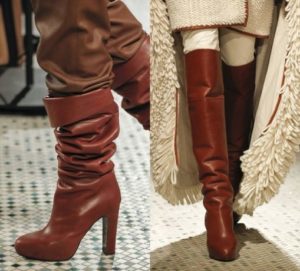 Leather and suede boots will sooner or later begin to deform due to slipping. Wrinkles will appear. The more there are, the worse the boot fits on the foot. As a result, the circle will close and you will have to get rid of the shoes that have lost their shape. Also, girls who have suddenly lost weight but decide to continue using their favorite pair of shoes cannot do without drastic measures. In their case, the difference between the new leg volume and the width of the boot is too great.
Leather and suede boots will sooner or later begin to deform due to slipping. Wrinkles will appear. The more there are, the worse the boot fits on the foot. As a result, the circle will close and you will have to get rid of the shoes that have lost their shape. Also, girls who have suddenly lost weight but decide to continue using their favorite pair of shoes cannot do without drastic measures. In their case, the difference between the new leg volume and the width of the boot is too great.
Folk tricks from craftswomen
Let's look at the most interesting options that you can do with your own hands.
Choosing the right clothes
The two most common reasons for boots slipping are poor fit and ease of slipping.They fall down especially quickly on nylon tights, and this is explained by the elasticity of the latter.
 Having found out the causes of the phenomenon, it is easy to find a solution. In this case, it is necessary to strengthen the fit of the boot and make it more difficult to slip off. From a school physics course it follows that slipping is prevented by roughness and unevenness. Based on this rule, we get that under the boots you should wear not thin nylon, but thick tights with a convex pattern. Of course, when choosing a pattern, you need to know when to stop - it should be invisible. Leggings should be made of rough, non-smooth material (for example, corduroy).
Having found out the causes of the phenomenon, it is easy to find a solution. In this case, it is necessary to strengthen the fit of the boot and make it more difficult to slip off. From a school physics course it follows that slipping is prevented by roughness and unevenness. Based on this rule, we get that under the boots you should wear not thin nylon, but thick tights with a convex pattern. Of course, when choosing a pattern, you need to know when to stop - it should be invisible. Leggings should be made of rough, non-smooth material (for example, corduroy).
Important! Some manufacturers of hosiery products for women produce specialized anti-slip tights.
Wear warm stockings
Putting knitted leggings on top of the tights (we are talking about machine knitting), you get:
 reduce the gap between the leg and the boot;
reduce the gap between the leg and the boot;- complement the look (socks and leg warmers peeking out from under shoes are in fashion);
- interfere with the sliding process (the effect is achieved only with a certain type of stocking);
- secure the boot with an elastic band (the leggings should have one).
For everything to work out, choose thick machine-knitted stockings with a convex pattern. In addition, they should have a fixing elastic band. And they should be longer than the boots, not much, 5–8 centimeters. They should be worn over tights. Next comes the boots. After putting them on, put the leg warmers over the top. Fold their edge straight with an elastic band.
Important! No stockings are needed if you wear shoes without tights. Over the knee boots slip off a naked body much worse than on clothes.
Double-sided body tape
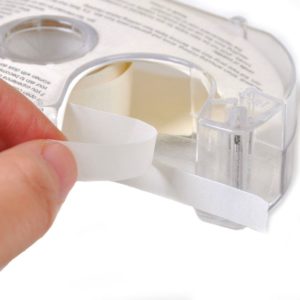 This idea seems crazy at first glance, but in fact, double-sided tape is a universal lifesaver.It is used when you need to beautifully drape fabric on an open back or fix the neckline in a very open dress. Stars who are forced to wear high heels despite the pain cannot do without it (at receptions they wear a pair 1-2 sizes larger, and glue their feet so that they do not slip in the sandal).
This idea seems crazy at first glance, but in fact, double-sided tape is a universal lifesaver.It is used when you need to beautifully drape fabric on an open back or fix the neckline in a very open dress. Stars who are forced to wear high heels despite the pain cannot do without it (at receptions they wear a pair 1-2 sizes larger, and glue their feet so that they do not slip in the sandal).
In the case of stocking boots adhesive double-sided tape will help fix the boot only for a short time. It will not be possible to determine the exact time, since there are a lot of unknowns: the materials of shoes and clothing play a role, as well as the degree of “stickiness” of the adhesive tape itself. The higher this quality, the longer the boots will stay in place.
Sewing in elastic
Option only for models in which the lock does not reach the end of the boot. A tight, but not too much elastic band is sewn into this area from the wrong side. It should not dig into the body with a death grip, otherwise it will be noticeable. And wearing boots will cause discomfort.
Sewing in a plastic or silicone base
An elongated piece of thin but durable plastic is placed on the back of the boot. It should go not horizontally, but vertically.
Creating loops
If you don’t mind jeans or leggings, sew small buttons to them, and eyelets closer to the edge of the top of the boots. In this case, the sliding boots will be fastened to the trouser leg.
Attaching anti-slip tape
A piece of rough, uneven fabric is used to surround the boot from the wrong side. Fleecy fabrics are also suitable as a restraining element.
Threading the wire
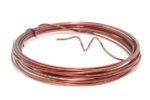 It is sewn to the wrong side at the level above the knee. The joint will not allow the wire to move lower. Consequently, the stocking boots will remain in place.
It is sewn to the wrong side at the level above the knee. The joint will not allow the wire to move lower. Consequently, the stocking boots will remain in place.
Creating a loop
Dancers at work resort to this very method.An elastic loop is sewn to the lining (not in a circle, but only in 1 place). When putting on shoes, the leg is put into a loop.
When should you sew your boots?
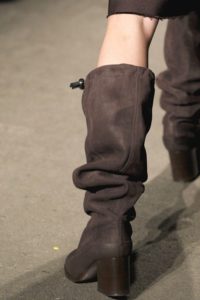 Elastic band, tape, stockings are measures designed only for light suede and fabric boots. If the stocking boots are made of genuine leather and have thick fur inside, then tricks will not help. The boot will continue to fall down, driven by its own gravity, and a small loop will not stop it. This requires drastic steps.
Elastic band, tape, stockings are measures designed only for light suede and fabric boots. If the stocking boots are made of genuine leather and have thick fur inside, then tricks will not help. The boot will continue to fall down, driven by its own gravity, and a small loop will not stop it. This requires drastic steps.
The same can be said for very wide models. If the boot does not fit the leg, and the top of the boot moves freely, then there is no point in sewing on elastic bands or inserting wire. You will have to adjust the product to size.
An attempt to get by with “little blood” will most likely be unsuccessful even with boots that end on the most mobile part of the leg – the knee. Constantly changing the position of the joint, extension, flexion will lead to lowering of the stocking boots. This problem is usually solved by sewing and creating a hem. Due to this, the bootleg will become shorter, and the movement of the knee will no longer cause the boot to fall off.


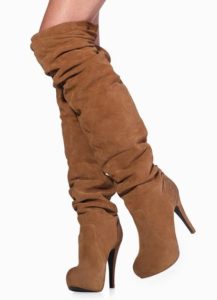 reduce the gap between the leg and the boot;
reduce the gap between the leg and the boot; 0
0





